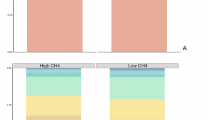Abstract
In experiments with ram rumen fluid the pH optimum for adhesion of rumen bacteria to cellulose and starch was found to be near 6. Addition of 1,4-dithiothreitol increased the adhesion logarithmically.
Similar content being viewed by others
References
Broberg G.: Measurement of the redox potential in rumen content:In vitro measurements of healthy and sick animals.Nordisk Veterinaermedicin 9, 918 (1957).
Cheng K.J., Akin D.E., Costerton J.W.: Rumen bacteria: Interaction with particulate dietary components and response to dietary variations.Fed. Proc. 36, 193 (1977).
Church D.C.:Digestive Physiology and Nutrition of Ruminants, Vol.1. O.S.U. Book Stores, Inc., Oregon 1969.
Cleland W.W.: Dithiothreitol, a new protective reagent for SH-groups.Biochemistry 3, 480 (1964).
Coleman G.S.: Rumen ciliate protozoa.Parasitology, AP,18, 121 (1980).
Forsberg C.W., Lam K.: Use of ATP as an indicator of the microbiota biomass in rumen content.Appl. Envir. Microbiol. 33, 528 (1977).
Francis G.L., Gawhorne J.M., Storer G.B.: Factors affecting the activity of cellulases isolated from the rumen digesta of sheep.Appl. Envir. Microbiol. 36, 643 (1978).
Geesey G.G.: Microbial exopolymers: Ecological and economical considerations.ASM News 48, 9 (1982).
Kopečný J., Wallace R.J.: Cellular location and some properties of proteolytic enzymes of rumen bacteria.Appl. Envir. Microbiol. 43, 1026 (1982).
Marounek M., Bartoš S.: Participation of microorganisms adherent on plant fibres in the breakdown of carbohydrates and in the metabolism of lactic acid in the rumen.Z. Tierphysiol. Tierernähr.Futtermittelkde 49, 66 (1983).
Minato H., Endo A., Higuchi M., Cotomo Y., Uemura T.: Ecological treatise on the rumen fermentation.J. Gen. Appl. Microbiol. 12, 39 (1966).
Minato H., Suto T.: Technique for fractionation of bacteria in rumen microbial ecosystem. I. Attachment of rumen bacteria to starch granules and elution of bacteria attached to them.J. Gen. Appl. Microbiol. 22, 259 (1976).
Minato H., Suto T.: Technique for fractionation of bacteria in rumen microbial ecosystem. II. Attachment of bacteria isolated from bovine rumen to cellulose powderin vitro and elution of bacteria attached therefrom.J. Gen. Appl. Microbiol. 24, 1 (1978).
Minato H., Suto T.: Technique for fractionation of bacteria in rumen microbial ecosystem. III. Attachment of bacteria isolated from bovine rumen to starch granulesin vitro and elution of bacteria attached thereform.J. Gen. Appl. Microbiol. 25, 71 (1979).
Minato H., Suto T.: Technique for fractionation of bacteria in rumen microbial ecosystem. IV. Attachment of rumen bacteria to cellulose powder and elution of bacteria attached to it.J. Gen. Appl. Microbiol. 27, 21 (1981).
Author information
Authors and Affiliations
Rights and permissions
About this article
Cite this article
Kopečný, J., Jurčuk, J.F. & Bartoš, S. The effect of pH and 1,4-dithiothreitol on the adhesion of rumen bacteria. Folia Microbiol 28, 130–133 (1983). https://doi.org/10.1007/BF02877369
Received:
Issue Date:
DOI: https://doi.org/10.1007/BF02877369




